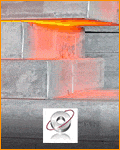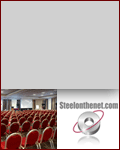History of Decarbonisation
The timeline below covers historical developments in hydrogen steelmaking technology and steel sector decarbonization in recent years, and describes future emission targets.
Note that the world steel industry contributed some 7% of global greenhouse gas emissions in 2016 [source: Our World in Data CO2 and Greenhouse Gas Emissions database].
- 2004: European steel industry launches ULCOS Project.
- 2006: ULCORED process is designed by a team led by LKAB, Voest-alpine and MEFOS.
- 2008: Commencement of Phase 2 of EU Emissions Trading Scheme.
- 2010: Tata Steel builds €20 million ULCOS HIsarna pilot plant at IJmuiden.
- 2012: ArcelorMittal withdraws from ULCOS CCS project at Florange, citing technical difficulties.
- 2013: Commencement of Phase 3 of ETS.
- 2015: Paris Agreement on climate change and CO2 targets is adopted by 196 parties.
- 2016: The HYBRIT initiative is launched in spring 2016.
- 2016: Abu Dhabi starts up world's first commercial steel carbon capture project.
- 2017: Cancellation of ROAD CCS project in Rotterdam.
- 2017: Construction of Kemper County Energy carbon capture facility is abandoned.
- 2018: Start-up of world's first waste gas to ethanol plant.
- 2019: Thyssenkrupp Stahl starts trials with blast furnace hydrogen injection.
- 2019: ArcelorMittal signs agreement with Midrex to build pilot hydrogen-only DRI plant in Hamburg.
- 2019: Salzgitter Flachstahl GmbH (SZFG) awards electrolysis plant contract to Siemens Gas and Power.
- 2020: Anglo moves to decarbonised mining with hydrogen truck project.
- 2020: HYBRIT commissions bio-oil plant at LKAB's Malmberget works.
- 2020: HYBRIT receives financial support from Swedish Energy Agency.
- 2020: European Investment Bank provides support to Steelanol project through €75M loan.
- 2020: Fortescue invests in hydrogen coaches at Christmas Creek.
- 2020: Ovako successfully uses hydrogen in Hofors reheat furnaces.
- 2020: Construction completed of SIDERWIN pilot plant building at Metz, France.
- 2020: BHP and China Baowu form carbon capture and storage JV.
- 2021: Start of Emissions Trading Scheme, Phase 4.
- 2021: Tenaris invests in hydrogen steelmaking in Italy.
- 2021: Voestalpine invests in new 250kt hydrogen-based pilot DRI plant in Austria.
- 2021: IOC joins forces with SHS and Paul Wurth to explore production of low emissions HBI.
- 2021: Liberty signs MoU with Paul Wurth & Stahl-Holding-Saar for H2 steelmaking trials.
- 2021: H2GS signals plans to build greenfield hydrogen steelmaking facility in Boden, Lulea (5mt capacity by 2030).
- 2021: Outokumpu joins TOCANEM to support carbon neutrality.
- 2021: SSAB, LKAB and Vattenfall commence construction of H2 storage rock cavern.
- 2021: Volvo, SSAB collaborate on first vehicles made of fossil-free steel.
- 2021: Hybrit pilot plant successfully produces ~100 tonnes of hydrogen-reduced sponge iron.
- 2022: Voestalpine studies use of hydrogen plasma for green steel production.
- 2022: Shanghai University team completes development test of blast furnace smelting with pure hydrogen.
- 2022: Anglo American unveils prototype of the world's largest hydrogen-powered mine haul truck.
- 2022: Rio Tinto signs MOU with Salzgitter to develop carbon-free SALCOS steelmaking.
- 2022: Hitachi signs MoU with H2GS for green steel collaboration, including electrolyzer construction.
- 2022: Tata Steel threatens to close down UK steelmaking unless given £1.5 billion in Aid.
- 2022: BMW Group signs agreement with H2GS for green steel supply.
Notes
- 2004: ULCOS denotes ultra low CO2 steelmaking. Initial ULCOS aim was to reduce steelmaking CO2 emissions by 50% by 2050. Some 47 partners across 15 European countries were involved in the ULCOS launch.
- 2005: Phase 1 of the ETS during 2005-2007 was essentially a 3-year pilot programme that helped to establish a carbon price; and set up an infrastructure in order to monitor, report and verify emissions from the relevant businesses.
- 2006: The ULCORED process produces DRI (direct reduced iron) in a shaft furnace, either from natural gas or from reducing gas obtained by gasification of coal, using 100% O2. Offgas from the shaft is recycled after the capture of the CO2 (which can then be stored).
- 2008: Phase 2 of the ETS took place over the period 2008-2012. During this period, concrete emission reduction targets were set, and trading in emissions allowances was allowed to develop. The aviation sector was brought into the EU ETS on 1 January 2012.
- 2010: HIsarna is a converter-based iron-making technology that directly converts iron ore and coal into iron (without raw material pre-treatment). HIsarna reduces CO2 emissions by ~20% compared to conventional ironmaking; and by up to 70% if used in conjunction with CCS.
- 2012: ArcelorMittal's withdrawal, as project Sponsor, from the ULCOS CCS project at Florange was ostensibly due to insurmountable technical challenges. The European Investment Bank had however subjected this and other ULCOS projects to a detailed technical and financial due diligence assessment some months previously, using blue-chip engineering consultancies for these evaluations. Notwithstanding ArcelorMittal's comments, these consultancies had deemed the CCS (and other ULCOS projects) to be sound.
- 2013: Phase 3 of the ETS took place between 2013-2020. During this period, a single EU-wide cap on emissions was introduced instead of the previous system of national emission allocations. Auctioning also became the default method for allocating allowances (instead of free allocation).
- 2015: Paris Agreement, agreed at COP21, is a legally binding international treaty on climate change that entered into force on 4 November 2016. It goal is to limit global warming to well below 2, preferably to 1.5 degrees Celsius, compared to pre-industrial levels.
- 2016: HYBRIT (an acronym for Hydrogen Breakthrough Ironmaking Technology) is a joint venture owned by the steel manufacturer SSAB, the mining company LKAB and the energy company Vattenfall. Its aim is the development of fossil-free ore-based steel manufacturing (using fossil-free electricity and hydrogen instead of coke and coal in steel production) with the target of having an operational industrial process in place by 2035.
- 2016: The Al Reyadah carbon-capture project (an Adnoc and Masdar joint venture) took 4 years to complete. Some 800,000 tonnes / year of carbon dioxide is taken from Emirates Steel's manufacturing plants in Abu Dhabi and transferred to the Al Reyadah plant for compression and dehydration. Gas is then exported through a buried pipeline for storage within Adnoc's NEB and Bab onshore oilfields.
- 2017: ROAD (which denotes Rotterdam Opslag en Afvang Demonstratieproject) was a demonstration project focusing on the capture of carbon dioxide at one of the coal-fired plants in Rotterdam and its storage in an empty gas field in the North Sea seabed. The project ran from 2009 to 2017 and was a joint project of Uniper (formerly E.ON) and Engie (formerly Electrabel and GDF Suez), and was financed by the European Commission, the Dutch Government, and the Port of Rotterdam amongst others. A collapse in the carbon price undermined the original business case ultimately leading to the project's failure.
- 2017: Kemper Country Energy Facility is an electricy generating plant based in Kemper County, Mississippi, USA. Its construction started in 2010, with initial plans for power generation being based on the use of locally-mined brown coal (lignite) as well as carbon capture and storage. As the project progressed, capital investment costs rose from $2.4 billion in 2014 to over $7.5 billion by 2017. In mid-2017, Mississippi Power announced that the power plant would switch to use of natural gas. Investment in the Kemper Project CCS facility was abandoned at that point.
- 2018: Carbon recycling firm LanzaTech and its joint venture partner Shougang Group announced the successful start-up of the world’s first commercial facility converting industrial carbon monoxide-containing waste gases to ethanol. The facility, located at the Jingtang Steel Mill in Hebei Province, began operations in May 2018 and produces 16 million gallons of ethanol per year in a anaerobic fermentation reaction.
- 2019: Thyssenkrupp Stahl trials involved injection of hydrogen into one of the 28 tuyeres on blast furnace 9 at the Duisburg-Hamborn site on November 11, 2019.
- 2019: ArcelorMittal Hamburg plant will have a DRI production capacity of 100 kt / year.
- 2019: Salzgitter steelmaking electrolysis plant is a 2.2 megawatt PEM facility (PEM = Proton Exchange Membrane) and is due to commence operation in the Q4 2020. Requisite electrical power will be generated by seven wind turbines with a capacity of 30 megawatt. Salzgitter project for greater use of hydrogen in steelmaking operations, jointly undertaken with the Fraunhofer Institute, is called SALCOS®.
- 2020: Ovako trial undertaken in collaboration with Linde, heating the steel to 1200C with hydrogen rather than LPG at the Hofors steel rolling mill in Sweden.
- 2020: SIDERWIN technology is based on reduction of iron ore by low-temperature electrolysis [electrowinning]. ArcelorMittal is the main Sponsor of the Siderwin project, which is supported by Euro 7 million of funding from the EU Horizon 2020 Programme. In 2021, the Siderwin technology will be further evaluated at the engineering-scale pilot plant at Metz. The SIDERWIN process is actually based on ULCOWIN technology, developed since 2004 under ULCOS. ULCOWIN is a low-temperature electrolysis process that produces solid state elemental iron from iron ore. Hematite (Fe2O3) particles are suspended in an alkaline electrolyte solution at about 100-110C. A electrical current is passed through the solution, from anode to cathode. Oxygen particles are attracted to the anode, and are released at the surface of the solution, and elemental iron forms crystals on the surface of the cathode. This iron is then fed into an electric arc furnace (EAF) with a small amount of coke or other carbon source to make crude liquid steel.
- 2020: HYBRIT pilot plant for hydrogen direct reduction of iron ore starts operation in Lulea on 31 August. Construction of a storage facility for hydrogen fuel at the HYBRIT pilot plant was a notable element in the total construction cost.
- 2020: ENGIE is providing the renewable hydrogen solution for Anglo American, which involves supply of hydrogen from the Nel Hydrogen Electrolyser AS for use in Anglo's fleet of haul trucks at its Mogalakwena mine.
- 2020: Steelanol consortium comprises ArcelorMittal, Lanzatech, Primetals and E4tech. Using Lanzatech's fermentation technology, this group is to construct an industrial-scale demonstration plant for the production of ethanol from blast furnace gas at ArcelorMittal's steel-making site in Ghent, Belgium.
- 2020: Fortescue coach project centres a $32 million agreement with BOC to establish a renewable hydrogen supply at the Christmas Creek iron ore mine in Western Australia. Investment in hydrogen production and refuelling infrastructure will be for a fleet of hydrogen coaches that transports workers from their base camp to the mine.
- 2020: LKAB reported that use of biofuel as a heat source for one of its pelletizing plants at Malmberget reduced carbon emissions by as much as 40 percent.
- 2020: BHP joint venture with Baowu Steel Group involves $35m investment to investigate carbon capture, use and storage at one of Baowu's Chinese blast furnaces.
- 2021: Phase 4 of the European Emissions Trading Scheme is expected to run between 2021-2030. Its aim is to ensure implementation by 2030 of targeted EU greenhouse gas emission reductions. To increase the pace of emission cuts, the overall number of emission allowances will decline each year during Phase 4. Note that in order to achieve the EU's overall greenhouse gas emissions reduction target for 2030, the sectors covered by the EU ETS must reduce their emissions by 43% compared to 2005 levels.
- 2021: Tenaris plan, being jointly developed with Italian energy suppliers Edison and SNAM, is to increase use of hydrogen in EAF steelmaking at the Dalmine seamless tube plant in Italy.
- Voestalpine pilot DRI facility is being built by Mitsubishi Heavy industries.
- 2021: IOC investigation into the potential for industrial scale low-carbon iron production in Canada is scheduled for completion in late 2021, with an investment decision on a hydrogen-based direct reduction iron (DRI) plant at industrial scale expected to follow. Iron Ore Company of Canada (IOC) will supply high-grade iron ores and expertise in mining, processing and pelletizing. Note that Rio Tinto owns 58.7% of IOC, with Mitsubishi Corp. and Labrador Iron Ore Royalty Corp. holding the rest. Paul Wurth has process knowledge in the field of highly efficient hydrogen generation. SHS group, which owns Europe-based Dillinger and Saarstahl, brings iron and steel making expertise.
- 2021: Liberty's pan-European partnership will work on construction of a two million tonne / year Direct Reduced Iron (DRI) plant with an integrated 1 GW capacity hydrogen electrolysis production unit based in Dunkerque, France. The DRI facility will initially use a mix of hydrogen and natural gas as the reductant to produce DRI and hot-briquetted iron (HBI). It will transition to use of 100% hydrogen once the electrolysis production unit is fully operational. The DRI will primarily be used in Liberty's Ascoval electric arc furnace in France.
- H2GS project in Boden Lulea (northern Sweden) is to produce hot and cold rolled coil, as well as galvanised sheet. Power is to be sourced from hydroelectric facilities in the area, as well as from wind farms. Construction is expected to start by mid-2022, with 2.5 mt/year of HRC and CRC capacity in place by 2026 and final capacity to be close to ~5 millin tonnes. Total capex cost is estimated at $3.04 billion.
- 2021: TOCANEM denotes 'Towards Carbon Neutral Metals'. It is a three year research programme involving a consortium of multiple metal industry companies. The project is geared to enable a shift to carbon neutral metal production in Finland.
- 2021: SSAB, LKAB and Vattenfall hydrogen storage facility in Svartöberget is to be located next to the investors' pilot HYBRIT facility in Luleå, Sweden. The cavern will have a storage volume of 100 cubic metres; will be locatd 30 metres underground; and its walls will be covered with a carefully selected material as a sealing layer (to ensure ost-effective storage under pressure).
- 2021: Volvo will start manufacturing the first concept vehicles and machines with hydrogen steel from SSAB in 2021. Plans are for small-scale serial production to start during 2022 and for a gradual escalation towards mass production to follow.
- 2021: The June 2021 technological breakthrough at HYBRIT in the production of DRI used hydrogen generated by electrolysis of water with fossil-free electricity.
- 2022: Voest Alpine hydrogen plasma research is to be undertaken at a new pilot facility at the firm's Donawitz site in southern Austria.
- 2022: Hitachi / H2GS MoU is based on three pillars 1) Hitachi Energy's equity investment in H2 Green Steel 2) Support from Hitachi Energy in order to construct and improve the electrical infrastructure to power steel production - including a large-scale electrolyzer plant 3) Boden green steel to then be used in the manufacturing of Hitachi Energy’s products, once H2 Green Steel commences production.
- 2022: Rio Tinto / Salzgitter project is intended to jointly study the use of Rio's Canadian and Australian iron ores for Salzgitter's SALCOS greensteel smelting project in Germany.
Targets
- 2022: Target date for ThyssenKrupp Stahl to adapt all BFs to hydrogen use; with 100% replacement of PCI with hydrogen injection. This should allow a 20% reduction in Thyssen's BF CO2 emissions.
- 2026: SSAB target date for closure of blast furnace in Oxelösund, Sweden.
- 2027: LKAB target date for construction of a hydrogen-based sponge iron plant in Sweden.
- 2030: UK goal is for emissions to fall by at least 68% by 2030, compared to 1990 levels.
- 2030: Date promised for peak CO2 production in China.
- 2045: Long-term target for zero net greenhouse gas emissions in Sweden.
- 2050: ThyssenKrupp target date for carbon neutrality.
- 2050: Posco target date to decarbonize steelmaking by using green hydrogen to replace coal.
- 2050: ArcelorMittal target for carbon neutrality in Europe.
- 2060: China target date for carbon neutrality.
Different colours of hydrogen
- Blue hydrogen: derived from natural gas through the process of reforming natural gas. Carbon dioxide that is produced in the reformation process is captured and stored underground (carbon capture & storage, CCS) leaving behind high-purity hydrogen.
- Green hydrogen: produced during the electrolysis of water. The process is powered by renewable energy sources, such as wind or solar.
- Grey hydrogen: comes from natural gas, in a process involving water called 'steam reforming'.
- Pink hydrogen: refers to hydrogen generated through electrolysis powered by nuclear energy.
- Yellow hydrogen: same as green, except that the power source is solar.
Other Definitions
- CCS: denotes carbon capture and storage. It refers to a process of capturing and storing carbon dioxide (CO2) before the gas is released into the atmosphere.
- Greenhouse gases: refer to carbon dioxide CO2, methane CH4, nitrous oxide N2O and fluorinated gases such as hydrofluorocarbons, perfluorocarbons, sulfur hexafluoride, and nitrogen trifluoride.
Back to Knowledge Base Index

© 2001 -
2024 Steelonthenet.com. All rights reserved.
To contact us about steel sector decarbonization and technological change email info@steelonthenet.com.
To contact us about steel sector decarbonization and technological change email info@steelonthenet.com.












